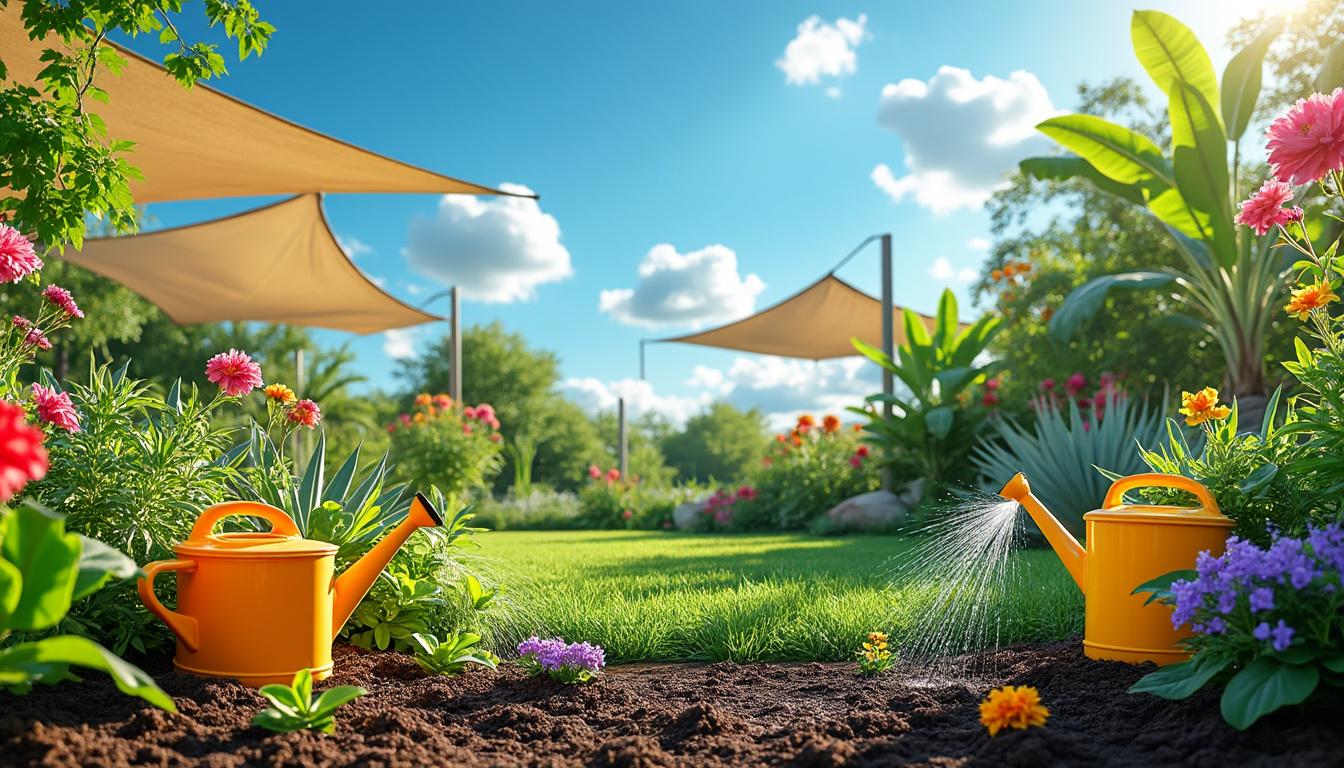As heat waves continue to intensify across the nation, the threat they pose to plant life in home gardens grows ever more critical. Extreme temperatures not only dehydrate soil but also stress plants, increasing vulnerability to pests and diseases. For gardeners who have invested time and resources using quality products like Miracle-Gro, Scott’s, and Dr. Earth, safeguarding these living assets demands strategic actions. Implementing effective watering techniques, mulching wisely, and providing shade are essential to maintaining plant vitality during the scorching summer months of 2025.
Best Practices For Watering Plants During A Heat Wave
Water management emerges as a vital factor in protecting plants from heat stress. Rather than frequent shallow watering, which can cause root rot and mold due to persistently damp soil, deep watering at intervals allows roots to grow deep and strong. Experts from arid regions recommend a cycle-and-soak irrigation method using systems such as Gardena drip lines or soaker hoses from HydroGarden, which promote efficient water use and reduce evaporation.
- Water every few days with a deep soak that reaches below the root zone.
- Use drip irrigation to conserve water and direct it precisely where needed.
- Avoid watering during peak heat to prevent stem burn; early morning or late evening is ideal.
- Monitor soil moisture regularly using a soil probe or by checking soil dampness with fingers.
| Watering Method | Advantages | Recommended Products |
|---|---|---|
| Cycle-and-Soak | Reduces runoff, promotes deep root growth | Gardena drip irrigation, HydroGarden soaker hoses |
| Hand Watering Deep | Flexibility for small gardens, targeted watering | Fiskars watering cans, Plant Rescue moisture meters |
| Automated Drip Systems | Water conservation, time-saving | HydroGarden automated kits, Bloem tubing |
Mulching Techniques To Protect Plants In Extended Heat
Mulching is a cost-effective and powerful tool to combat the adversities caused by heat waves. By covering soil with organic or synthetic mulch, gardeners limit moisture evaporation, suppress weed growth, and stabilize soil temperature. According to experts, a moderate layer of mulch—neither too thick nor too thin—strikes the perfect balance for plant health. Brands like Ecovessel offer sustainable mulch options that improve soil health while being environmentally responsible.
- Apply a 2-3 inch layer of mulch around plants but keep it slightly away from stems to prevent rot.
- Use natural mulches such as wood chips or bark from Bloem for added nutrients as they decompose.
- Replenish mulch layers regularly, especially before peak summer heat periods.
- Combine mulching with bio-fertilizers such as Bonide or Dr. Earth for enhanced plant resilience.
| Mulch Type | Benefits | Recommended Brands |
|---|---|---|
| Organic Mulch | Improves soil fertility, retains moisture | Bloem wood chips, Ecovessel bark mulch |
| Synthetic Mulch | Long-lasting moisture barrier, reduces weeds | Gardena landscape fabric |
Planting Season Timing To Reduce Heat Stress
Proper timing plays a crucial role in plant establishment during the warmer months. Avoid introducing new plants during the height of the heat wave; stress from transplant shock under extreme heat can be fatal. Instead, plan planting in early spring or fall, allowing roots to develop before confronting intense temperatures. These practices align with advice found in seasonal planting guides designed to aid gardeners in diverse climates.
Providing Shade To Mitigate Intense Sun Exposure
In scenarios where heat and sun intensity surpass natural thresholds, adding shade structures is a practical solution. Using shade cloths that block approximately 30% of sunlight prevents sunburn and reduces transpiration stress. Simple aids such as shading potted plants indoors or placing window screens outdoors can suffice. For those who want to invest in technical shading solutions, products associated with Plant Rescue or Scott’s offer durable and effective options.
- Utilize horticultural shade cloths rated for 30% sunlight blockage.
- Relocate containers to cooler or shaded areas during peak heat.
- Set up temporary covers like umbrellas or netting to protect sensitive plants.
- Regularly assess plant response to shade to avoid over-shading risks.
Identifying Plants In Need Of Emergency Care During Heat Waves
Recognizing early signs of heat stress is vital for implementing timely rescue measures. Symptoms such as leaf curling, wilting, and discoloration often indicate critical hydration deficits. Gardeners should observe both visual cues and soil moisture levels to prioritize interventions. Using tools like soil moisture meters from Plant Rescue or simple tactile tests help determine urgency.
- Look for wilting or curled leaves as initial stress indicators.
- Monitor soil for moisture content especially around roots.
- Check for yellowing or leaf drop which signal severe distress.
- Respond immediately with deep watering or relocation to shade.
| Symptom | Cause | Recommended Action |
|---|---|---|
| Leaf Curling | Lack of moisture, heat stress | Increase watering frequency, provide shade |
| Wilting | Dehydration, root damage | Deep soak watering, check soil drainage |
| Yellow Leaves | Prolonged heat exposure, nutrient deficiency | Apply fertilizers like Miracle-Gro or Bonide suited for heat-stressed plants |
Additional Tips For Sustainable Gardening During Heat Waves
- Implement water-saving techniques as detailed in this guide on garden watering during heatwaves.
- Incorporate organic amendments like Dr. Earth fertilizers to enhance soil moisture retention.
- Use budget-friendly pest control methods from resources such as this ant elimination trick to prevent insect infestations exacerbated by heat stress.
- Consider crop rotation and companion planting to improve soil health and reduce vulnerability, aligning with tips in gardening advice for novices.
Frequently Asked Questions About Protecting Plants From Heat Waves
- How often should I water plants during a heat wave? Deep watering every two to three days is recommended to ensure moisture reaches deep roots, avoiding constant surface watering risks.
- Can mulching really reduce soil temperature? Yes, mulching acts as an insulator, keeping soil cooler and retaining moisture, thereby mitigating heat stress effectively.
- What signs indicate a plant is too hot? Common indicators include leaf curling, wilting, yellowing, and leaf drop, signaling urgent intervention.
- Is it better to shade plants or let them endure sun exposure? Providing shade during peak heat prevents damage and promotes recovery, though balance is necessary to avoid over-shading side-effects.
- Are irrigation systems worth the investment? Absolutely, systems like Gardena drip irrigation save water, reduce labor, and enhance plant health during prolonged heat spells.

